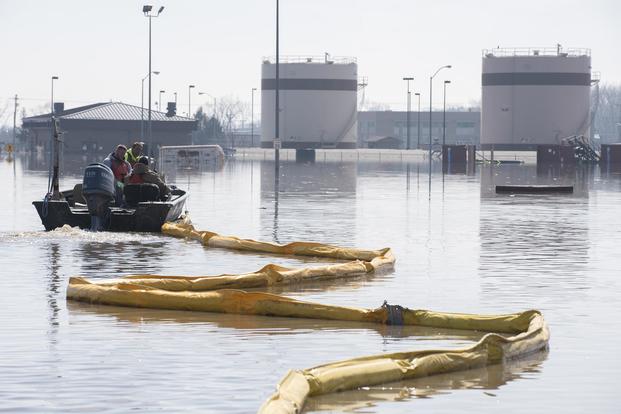Unforeseen storms that have slammed two Air Force bases in six months may force the service to dip into next year's yet-to-be-approved budget -- money that had been earmarked for updates to bases worldwide.
Without extra funding from lawmakers, reconstruction to both Tyndall Air Force Base, Florida, and Offutt Air Force Base, Nebraska, will force the Air Force to draw from next year's operations and maintenance funding, said John Henderson, Assistant Secretary of the Air Force for Installations, Environment and Energy.
The service earlier this week unveiled a new plan to update bases with eroded infrastructure and those that haven't received modernization improvements in the last 20 years. Dubbed the Air Force infrastructure investment strategy, or "I2S," the effort is set to be funded starting next fiscal year, if the budget request made public earlier this month is approved by Congress.
Henderson said the service is planning for a $2 billion increase from last year's O&M request: an additional $1.3 billion in facility sustainment, restoration and modernization, and $700 million in military construction recapitalization.
Related content:
- Offutt Air Force Base Cancels Airshow after 'Historic Disaster' Floods
- Air Operations Unaffected After Tornado Hits Tyndall
- Air Force Requests Billions to Modernize Crumbling Base Infrastructure
Because of neglected maintenance over the last two decades at all 180 of its installations, the service has racked up $33 billion in backlogged work that needs to be done to fix buildings, runways, heating, ventilation and air conditioning systems officials said.
The backlog is expected to triple over the next 30 years.
Much like a Navy battle carrier group, Henderson explained, Air Force bases are at the core of how the service projects airpower across the world.
"Bases have to be ready now, they have to be ready for major conflict, and so we can only take so much risk there before the foundational readiness of the infrastructure starts to impact the readiness of our warfighting operations," Henderson said.
The I2S strategy will not necessarily be a "worst-first" strategy, Henderson said. Instead, he said, each base will get incremental updates over time in order to avoid getting to a point of "triage."
While urgent repair needs are typically attended to, officials find themselves running out of money for other bases that are more slowly degrading, Henderson said.
The fundamental strategy to invest in base infrastructure gradually in coming years will not change. But the service is hoping a supplemental funding bill from Congress will keep it from having to divert funds from early stages of the effort.
"We're going through ... the current-year Air Force operations and maintenance funds to do those repairs" to Tyndall Air Force Base under the assumption that there will be supplemental funding or reprogrammed money to assist with the work, Henderson said.
He added, "We're kind of counting on that."
Last week, Air Force Secretary Heather Wilson said the service has already used up $410 million operations and maintenance funds for Tyndall, "and we expect by the end of this year, it's going to be about $750 million for recovery."
Wilson also said the service will rely heavily on a supplemental funding bill, and that lawmakers should be discussing how best to move dollars forward.
"There is nothing in the constitution that says that you have to propose something from the administration in order to get a supplemental going. I used to work this on [Capitol] Hill on the House side," Wilson told reporters after a Senate Appropriations defense subcommittee hearing March 13.
When asked if Congress should be already moving forward with a proposal, Wilson responded, "You bet."
Officials at Offutt -- which has been swamped by floodwaters -- have yet to determine a cost for damages sustained over the last few days.
But the backlog of projects is already growing, aside from Tyndall and Offutt repairs.
The Air Force has been working through "60 to 70" backlogged projects, and if funding continues to be diverted, the backlog can only grow, Henderson said.
"None of this really gets better until we can defend the budget and get the funding in the system to make better investments," he said.
The investments also include downsizing -- to a degree, Henderson said.
"The goal is to create enduring plans for the installations we need while reducing total facility square footage by five percent in 20 years through divestment, demolition, conversion, and consolidation," the plan states.
Not all bases will see a five percent cut at their installations; some may see more, others less depending on their mission, Henderson said.
According to the strategy, bases can optimize their resources through use and reuse of existing facilities, and "offset new construction growth, and divest failing and underutilized facilities."
Some bases in Europe and the Pacific are also slated to grow, so cuts wouldn't necessarily make sense, he said.
Henderson said environmental and civil engineers will use data analysis and technology to establish better business models to run each facility. In some cases, they'll use IBM Watson, an artificial intelligence "supercomputer" which can predict or flag items that may need upgrades as well as solutions for how to fix them.
"We're testing some of those technologies right now, and we would like to get those on all of our buildings so they can be centrally monitored and tracked ... and be able to be predictive about the maintenance," he said.
The strategy is about "having a 'get well' plan," Henderson said. "It's unsustainable to continuously plan for things to fail."
-- Oriana Pawlyk can be reached at oriana.pawlyk@military.com. Follow her on Twitter at @oriana0214.














